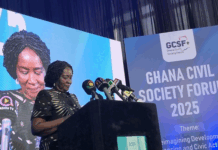By Jabesh Amissah-Arthur
Africa stands at a critical juncture. Its population is booming, its aspirations for economic development are soaring, and its electricity demand is skyrocketing. This presents a complex challenge: how can the continent achieve economic development and deliver quality electricity services for its population while simultaneously mitigating the effects of climate change?
Traditional solutions for sustainability often force a harsh choice on African countries, their economies, and their people: prioritize economic growth through increased energy consumption or prioritize climate mitigation and emissions reductions through, often, more financially costly solutions options and stricter environmental regulations limiting land and resource use. However, there exists a powerful, and often overlooked, weapon in Africa’s arsenal to deliver cheaper and improved electricity services to fuel economic growth while contributing significantly towards creating viable conditions for climate mitigation and emissions reductions – Distribution Utility Energy Efficiency (DUEE).
Africa’s achievement of its developmental and other ambitions across sectors is dependent on the affordability, availability, and efficiency of electricity systems. However, on these measurables, the African continent has the highest average electricity tariffs, the highest unelectrified population, and the highest electricity losses in the world. Distribution Utility Energy Efficiency (DUEE) is a significant lever that can help to provide enabling conditions for improvements in all three of these measurables and areas of performance.
Distribution Utilities are the primary commercial transaction entity of electricity value chains all over the world; Africa is no different. The operational and financial health of these utilities is a significant determinant of the health of the entire electricity value chain – including transmission, generation, and fuel supply. Over time, the effectiveness and performance (operationally and financially) of distribution utilities affect several other electricity-tied activities including affordability and availability of electricity to support economic growth, facilitate improved electricity access and support critical quality of life interventions such as education and health.
Currently, most Energy Efficiency funding in Africa focuses on Demand-Side Initiatives (DSIs). These initiatives encourage consumers to use less energy, a vital step in responsible resource management. However, the limitations of this approach become evident when considering the unique context of Africa. A 2021 report by the International Energy Agency (IEA) paints a stark picture. For the first time in decades, the number of people around the world without access to electricity was set to rise in 2022, reaching 760 million people. This growth is seen mainly in Sub-Saharan Africa, which accounts for 80% of people lacking electricity access.
A paradigm shift is urgently needed. By strategically redirecting EE funding to facilitate climate mitigation objectives through loss reduction for Distribution Utilities, Africa can achieve significant emissions reductions, not only without sacrificing but, while catalysing crucial development objectives. This approach prioritizes interventions that directly address the inefficiencies within existing electricity distribution operations.
To begin with, significant opportunities lie in reducing distribution losses. The World Bank estimates that Sub-Saharan Africa loses an average of 22% of its electricity during transmission and distribution. Investing in distribution utility performance improvement can dramatically lower these losses thereby directly improving the financial health of distribution utilities and, by logical extension, the entire electricity supply value chain. Such an investment not only reduces the environmental impact of electricity generation but also makes more power available to consumers.
This strategic approach directly translates into achieving Africa’s most critical development objectives.
By reducing losses across the distribution grid, overall system costs decrease. This translates to more affordable electricity for consumers and businesses, a key driver of economic growth and improved quality of life. In addition, with more efficient use of existing generation capacity, there is more electricity available to facilitate electricity access for more people. This helps to unlock a multitude of potential benefits – from improved healthcare and education to increased productivity and economic empowerment.
Further, reliable, and affordable electricity is the backbone of a thriving economy. Reduced losses and improved operating efficiency strengthen distribution utilities, facilitate financial viability, and better equipped to support industrial growth. A stable and efficient power grid fosters a more attractive investment environment, further accelerating development.
The potential benefits are not a mere speculation. Energy Efficiency directly reduces emissions by minimizing energy waste. According to the International Energy Agency (IEA) report, implementing cost-effective energy efficiency measures would have led to a peak in energy-related GHG emissions before 2020 and substantial reductions by 2040. In fact, energy efficiency could deliver over 40% of the GHG emissions reduction required to meet the Paris Agreement targets.
Distribution Utility Energy Efficiency is not a standalone solution, but rather a powerful tool that can be wielded effectively to advance creation of an enabling environment for improved adoption of comprehensive climate change strategies. Renewable Energy sources will undoubtedly play a vital role in Africa’s future energy mix. However, integrating these renewables requires a robust and efficient grid infrastructure – exactly what a strategic focus on energy efficiency can help to achieve.
The road to a sustainable future for Africa requires a multi-pronged approach. Distribution Utility Energy Efficiency stands out as a strategy that delivers a win-win scenario – addressing climate change concerns while simultaneously powering economic growth and improving the lives of millions of Africans.
This requires a shift in focus from simply reducing demand to optimizing the entire energy ecosystem. Governments, international organizations, and the private sector must work together to develop and implement a comprehensive, data driven DUEE strategy for Africa. This strategy should prioritize investments in data-driven loss reduction initiatives that prioritize and progressively implement starting with the highest return on investment (ROI) interventions.
Financing this shift will require innovative solutions and a willingness to rethink the application of existing funding for initiatives that no longer generate the highest possible impact and ROI for African electricity sectors and their economies.
Distribution Utility Energy Efficiency is not a silver bullet, but it is a powerful weapon and high leverage intervention in Africa’s fight for a sustainable future. By strategically redirecting energy efficiency funding to support distribution utility performance improvement via data-driven loss reduction interventions, Africa can achieve significant climate mitigation objectives while simultaneously powering its development and economic growth. This win-win scenario requires a shift in focus and a willingness to redirect existing resources, but the potential rewards – a cleaner, brighter future for Africa – are well worth the effort.
The writer is the Partner, Arthur Energy Advisors based in Ghana










